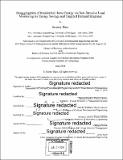Disaggregation of residential home energy via non-intrusive load monitoring for energy savings and targeted demand response
Author(s)
Hare, Jeremy (Jeremy B.)
DownloadFull printable version (7.928Mb)
Other Contributors
Leaders for Global Operations Program.
Advisor
Georgia Perakis, John Williams, and Kostya Turitsyn.
Terms of use
Metadata
Show full item recordAbstract
Residential energy disaggregation is a process by which the power usage of a home is broken down into the consumption of individual appliances. There are a number of different methods to perform energy disaggregation, from simulation models to installing "smart-plugs" at every outlet where an appliance is connected to the wall. Non-Intrusive Load Monitoring (NILM) is one such disaggregation option. NILM is widely recognized as one of the most cost-effective methods for gathering disaggregated energy data while maintaining a high level of accuracy. Although the technology has existed for many years, the adoption rate of NILM, and other devices that disaggregate energy, has been minimal. This thesis provides details on the potential benefits, both for the customer and utility provider, associated with furthering the adoption of NILM devices and obtaining the disaggregated appliance level energy-use. A broad overview of potential benefits is presented; however, the primary goal of this thesis will be to investigate two benefits of NILM in detail: overall household energy reduction and targeted demand response. First, installation of a NILM device can provide electricity customers information that allows them to become more aware of their energy consumption, and thereby, more energy efficient. A study was conducted that looked at the electricity consumption of 174 homes that were using a passive NILM device in their home. This NILM device provided immediate feedback on the power consumption for a portion of the home's appliances via smart-phone application. The homes reduced their monthly energy consumption by an average of 2.6 - 3.1% after the NILM installation. This was validated by a number of analysis methods returning similar results. Aligned with this benefit comes a recommendation for an incentive structure that can reduce the price paid by the consumer and develop a higher adoption rate of NILM devices. Second, the wide-spread adoption of NILM devices can provide electric utilities information to reduce carbon intensity via targeted demand response. There is a significant opportunity for utilities to engage their customers based on the time of use of detailed appliances. Multiple metrics are presented in this thesis to quantify the deferrable load opportunity of specific appliances and individual households. Utility operational cost savings and greater customer incentives can be linked to the use of these metrics.
Description
Thesis: M.B.A., Massachusetts Institute of Technology, Sloan School of Management, in conjunction with the Leaders for Global Operations Program at MIT, 2018. Thesis: S.M., Massachusetts Institute of Technology, Department of Civil and Environmental Engineering, in conjunction with the Leaders for Global Operations Program at MIT, 2018. "June 2018." Cataloged from PDF version of thesis. Includes bibliographical references (pages 59-61).
Date issued
2018Department
Leaders for Global Operations Program at MIT; Massachusetts Institute of Technology. Department of Civil and Environmental Engineering; Sloan School of ManagementPublisher
Massachusetts Institute of Technology
Keywords
Sloan School of Management., Civil and Environmental Engineering., Leaders for Global Operations Program.